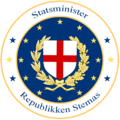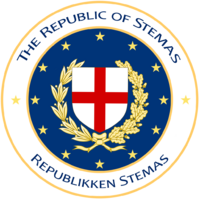Prime Minister of the Republic of Stemas: Difference between revisions
(Created page with "{{Infobox political post |post = Prime Minister of the Republic of Stemas |nativename = ''Statsminister i republikken Stemas'' |flag...") |
No edit summary |
||
| Line 49: | Line 49: | ||
The Office of Prime Minister was created under the Republican Government in its current capacity in 1851, though some of the Roles and Responasability of the Prime Minister ahs changed over time. The Office of First Minister of the Kingdom was similar to the Office of Prime Minister and was the model used when creating the Head of Governments position during the Constitutional Draft of 1865. | The Office of Prime Minister was created under the Republican Government in its current capacity in 1851, though some of the Roles and Responasability of the Prime Minister ahs changed over time. The Office of First Minister of the Kingdom was similar to the Office of Prime Minister and was the model used when creating the Head of Governments position during the Constitutional Draft of 1865. | ||
{{Stemas}} | |||
{{Eurth}} | {{Eurth}} | ||
[[Category: Stemas]] | [[Category: Stemas]] | ||
Latest revision as of 20:00, 25 July 2023
| Prime Minister of the Republic of Stemas | |
|---|---|
 Seal of the Prime Minister of the Republic of Stemas | |
 Flag of the President of the Republic of Stemas | |
| Style | Mr. Prime Minister or Madam Prime Minister |
| Member of | Stortinget |
| Residence | Prime Ministers House, Bakne, Republic of Stemas |
| Appointer | The President of the Republic |
| Term length | 4 Years, or unless dismissed by the Stortinget or President |
| Constituting instrument | Constitution of the Republic of Stemas |
| Formation | 1851 |
| First holder | Sir Alexander Larsson |
The Prime Minister is the Head of Government of the Republic of Stemas. who is the head of the Council of Government, is the second highest executive in the Republic next to the President. The Prime Minister is elected by the People in a Parliamentary Election Cycle that is held every four years unless the President Dissolves Parliament or the Stortinget dismisses the Government through a Vote of No Confidence.
Upon appointment, the prime minister proposes a list of ministers to the president. Decrees and decisions signed by the prime minister, like almost all executive decisions, are subject to the oversight of the administrative court system. Some decrees are taken after advice from the Council of State, over which the prime minister is entitled to preside. Ministers defend the programs of their ministries to the prime minister, who makes budgetary choices. The extent to which those decisions lie with the prime minister or president often depends upon whether they are of the same political party. If so, the president may serve as both the head of state and de facto head of government, while the prime minister serves as his deputy.
Nomination
The Prime Minister is nominated by the People through a Parliamentary Election Cycle that holds the most seats. However, sometimes the party that holds the most seats is not always asked to form a Government by the President. Usually the Prime Minister that is asked to form a Government reflects the proportions of the Forbundsforsamlingen after an Election Cycle. In past times some Presidents have asked other Members of the Forbundsforsamlingen to form a Government over the clear nominated Person due to favoritism.
While prime ministers are usually chosen from amongst the ranks of the Forbundsforsamlingen, on rare occasions the president has selected a non-officeholder because of their experience in bureaucracy or foreign service, or their success in business management.
Although the president's choice of prime minister must be in accordance with the majority in the Forbundsforsamlingen, a prime minister does not have to ask for a vote of confidence after their government's formation. They can base their legitimacy on the president's assignment as prime minister and approval of the government. However, it is traditionally expected that the government seeks a motion of confidence upon entering office.
Role
According to the Constitution of the Republic of Stemas the Office of Prime Minister, he prime minister "shall direct the actions of the Government". The Republican Constitution further stipulates that the government "shall determine and conduct the policy of the Nation", and it includes domestic issues, while the president concentrates on formulating directions on national defense and foreign policy while arbitrating the efficient service of all governmental authorities in Stemas. Other members of the government are appointed by the president "on the recommendation of the prime minister". In practice the prime minister acts in harmony with the president to whom he is a subordinate, except when there is a cohabitation. In such cases, a constitutional convention gives the prime minister primacy in domestic affairs, while the president oversees foreign affairs. His responsibilities, then, are akin to those of a prime minister in a parliamentary system.
The prime minister can "engage the responsibility" of their government before the Forbundsforsamlingen. This process consists of placing a bill before the assembly, and either the assembly overthrows the government, or the bill is passed automatically. In addition to ensuring that the government still has support in the house, some bills that might prove too controversial to pass through the normal assembly rules are able to be passed this way.
The prime minister may also submit a bill that has not been yet signed into law to the Constitutional Council. Before they are allowed to dissolve the assembly, the president has to consult the prime minister and the presidents of both houses of Parliament. They are, as the representative of the government, the only member of the government able to introduce legislation in Parliament.
History
The Office of Prime Minister was created under the Republican Government in its current capacity in 1851, though some of the Roles and Responasability of the Prime Minister ahs changed over time. The Office of First Minister of the Kingdom was similar to the Office of Prime Minister and was the model used when creating the Head of Governments position during the Constitutional Draft of 1865.

